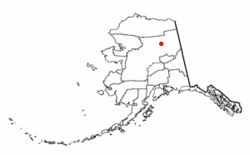Venetie, Alaska facts for kids
Quick facts for kids
Venetie
Vįįhtąįį
|
|
|---|---|

Location of Venetie, Alaska
|
|
| Country | United States |
| State | Alaska |
| Census Area | Yukon–Koyukuk |
| Area | |
| • Total | 23.01 sq mi (59.59 km2) |
| • Land | 23.01 sq mi (59.59 km2) |
| • Water | 0.00 sq mi (0.00 km2) |
| Population
(2020)
|
|
| • Total | 205 |
| • Density | 8.91/sq mi (3.44/km2) |
| Time zone | UTC-9 (Alaska (AKST)) |
| • Summer (DST) | UTC-8 (AKDT) |
| ZIP code |
99781
|
| Area code | 907 |
| FIPS code | 02-82420 |
Venetie is a small community in Alaska. Its name in the Gwich’in language is Vįįhtąįį. Venetie is a census-designated place (CDP). This means it is a place that the government counts for the census. It is not a city with its own local government. In 2020, about 205 people lived there. Venetie is home to the Gwich'in people. They are an Alaska Native tribal group.
Contents
History of Venetie's Land
The Gwich'in people have lived in the Venetie area for a very long time. In 1941, a Gwich'in leader named John Fredson helped get federal recognition for the Venetie Indian Reserve. This was before Alaska became a state. It was the largest reservation in Alaska. It covered about 1.4 million acres.
Changes to Tribal Lands
In 1971, a law called the Alaska Native Claims Settlement Act (ANCSA) was passed. This law changed how land was owned by Native groups in Alaska. Most reservations were ended. The government paid tribes for their land. It also set aside new areas as tribal lands. The Gwich'in tribal lands became smaller under this act.
Protecting Caribou
The Gwich'in people have always lived off the land. They follow traditional ways of life. In the early 1980s, the Venetie and Arctic Village tribal governments made a special law. This law helped manage the hunting of caribou. Caribou are very important to the Gwich'in people. This showed how traditional ways can work with modern rules. It helped keep their culture strong.
Discussions About Taxes
In 1987, the Gwich'in tribal council tried to tax a company. This company was building a school in Venetie. The council said they had the right to tax businesses on their land. They believed their land was like "Indian Country" in other states. This means it would have special tribal government rights.
The case went to court. In 1996, a court said the Gwich'in could tax businesses on their land. They agreed it was like Indian Country. But the state of Alaska disagreed. They worried that many tribal lands in Alaska would be taxed by tribes.
In 1998, the highest court in the U.S., the United States Supreme Court, heard the case. It was called Alaska v. Native Village of Venetie Tribal Government. The court decided that the tribal council could not tax the company. They said that the 1971 Alaska Native Claims Settlement Act changed things. It meant that tribal lands in Alaska do not have the same special status as older Indian reservations in other states.
Geography of Venetie
Venetie is located in northern Alaska. It sits by the Chandalar River. The area is about 20.8 square miles (53.9 square kilometers). All of this area is land.
People of Venetie
| Historical population | |||
|---|---|---|---|
| Census | Pop. | %± | |
| 1940 | 86 | — | |
| 1950 | 81 | −5.8% | |
| 1960 | 107 | 32.1% | |
| 1970 | 112 | 4.7% | |
| 1980 | 132 | 17.9% | |
| 1990 | 182 | 37.9% | |
| 2000 | 202 | 11.0% | |
| 2010 | 166 | −17.8% | |
| 2020 | 205 | 23.5% | |
| U.S. Decennial Census | |||
Venetie first appeared in the U.S. Census in 1940. Most people living in Venetie are Native American. Many are Gwich'in Athabaskan. In 2000, about 92% of the people were Native American. The average age of people in Venetie was 25 years old.
Education in Venetie
The Yukon Flats School District runs the local school. It is called the John Fredson School.
See also
 In Spanish: Venetie (Alaska) para niños
In Spanish: Venetie (Alaska) para niños

